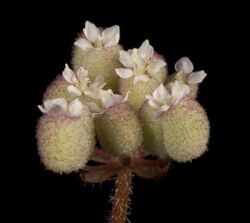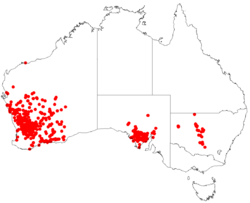Biology:Trachymene ornata
| Trachymene ornata | |
|---|---|

| |
| Scientific classification | |
| Kingdom: | Plantae |
| Clade: | Tracheophytes |
| Clade: | Angiosperms |
| Clade: | Eudicots |
| Clade: | Asterids |
| Order: | Apiales |
| Family: | Araliaceae |
| Genus: | Trachymene |
| Species: | T. ornata
|
| Binomial name | |
| Trachymene ornata | |

| |
| Occurrence data from AVH | |
| Synonyms[3] | |
|
Cesatia ornata Endl.
Didiscus eriocarpus (F.Muell.) F.Muell. | |
thumb|left|Trachymene ornata thumb|left|Trachymene ornata fruit
Trachymene ornata, or spongefruit, is a slender annual herb in the family Araliaceae.[4] It is native to Australia and found in Western Australia, South Australia and New South Wales.[5][4][6]
Description
Trachymene ornata is an annual herb growing up to 15 centimetres (6 in) high,[5][4] which has sparsely hairy stems.[5] The sparsely hairy leaves are deeply three-lobed almost to dissected.[5] The inflorescence is an umbel of 3-6 flowers[6] which are bisexual, white or blue, and observed (in NSW) from July to October.[5] The two-carpelled fruits split into two densely woolly mericarps with white (sometimes purplish) hairs.[6]
Habitat
It grows in rocky places, and in shallow soils[5][4]
Taxonomy
Trachymene ornata was first described by Stephan Endlicher in 1839,[7][8] and redescribed by Druce in 1917 as belonging to the genus, Trachymene Rudge.[1]
References
- ↑ 1.0 1.1 Druce, G.C. 1917. "Nomenclatorial Notes: chiefly African and Australian." The Botanical Exchange Club and Society of the British Isles Report for 1916, Suppl. 2: 650
- ↑ "APNI: Trachymene ornata". IBIS database. Centre for Plant Biodiversity Research, Australian Government, Canberra. https://biodiversity.org.au/nsl/services/instance/apni/551099. Retrieved 12 June 2018.
- ↑ Govaerts, R. et.al. 2018. "Plants of the world online:Trachymene ornata". Board of Trustees of the Royal Botanic Gardens, Kew. https://powo.science.kew.org/taxon/urn:lsid:ipni.org:names:849726-1. Retrieved 12 June 2018.
- ↑ 4.0 4.1 4.2 4.3 "FloraBase: Trachymene ornata.". Western Australian Herbarium, Biodiversity and Conservation Science, Department of Biodiversity, Conservation and Attractions.. https://florabase.dpaw.wa.gov.au/browse/profile/6279. Retrieved 12 June 2018.
- ↑ 5.0 5.1 5.2 5.3 5.4 5.5 Hart, J.M. 2002. "PlantNET: Trachymene ornata". National Herbarium of NSW, Royal Botanic Gardens, Sydney. http://plantnet.rbgsyd.nsw.gov.au/cgi-bin/NSWfl.pl?page=nswfl&lvl=sp&name=Trachymene~ornata. Retrieved 12 June 2018.
- ↑ 6.0 6.1 6.2 "efloraSA Electronic Flora of South Australia factsheet: Trachymene ornata". Department of Environment, Water and Natural Resources, Government of South Australia. http://www.flora.sa.gov.au/cgi-bin/speciesfacts_display.cgi?form=speciesfacts&family=&genus=trachymene&species=ornata&iname=&submit=Display. Retrieved 12 June 2018.
- ↑ "IPNI: Cesatia ornata". International Plant Name Index. http://www.ipni.org/ipni/idPlantNameSearch.do?id=61227-3. Retrieved 12 June 2018.
- ↑ Endlicher, S.L. 1839. Annalen des Wiener Museums der Naturgeschichte 2 1839 = Stirpium Australasicarum Decades III
External links
| Wikimedia Commons has media related to Trachymene ornata. |
Wikidata ☰ {{{from}}} entry
 |

